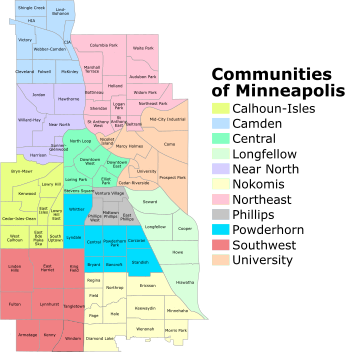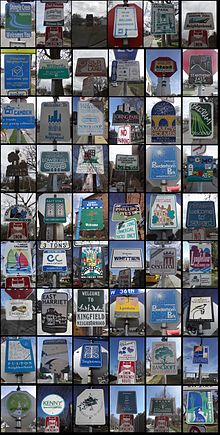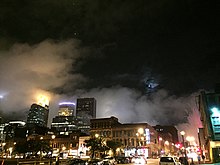Neighborhoods of Minneapolis

Minneapolis is officially defined by its city council as divided into 83 neighborhoods. The neighborhoods are historically grouped into 11 communities. Informally, there are city areas with colloquial labels. Residents may also group themselves by their city street suffixes: North, Northeast, South, and Southeast.
Description[edit]
General areas[edit]
The local community defines several general areas based on the directional suffixes added to streets in the city. These city areas do not necessarily correlate with official community or neighborhood definitions.
Downtown Minneapolis refers to the street grid area aligned on a diagonal with the Mississippi River bend, as opposed to the true north-south grid orientation. The area north of downtown on the west bank of the Mississippi River is considered North Minneapolis. The part of Minneapolis on the east bank of the Mississippi River is divided by East Hennepin Avenue into Northeast and Southeast, approximately aligned with the communities of Northeast and University, respectively.
The entire area south of downtown is widely called South Minneapolis. The westerly portion surrounding the city's Chain of Lakes is loosely labeled Southwest Minneapolis, bounded on the east by I-35W and on the north by 36th St W, which extends west from Bde Maka Ska to the city limits.
Common conceptions of Minneapolis neighborhoods do not always align with official city maps. Residents on the borders of surrounding cities may sometimes say they live in a bordering community. Twin Cities residents and visitors frequently use generalized names based on geography, such as "North Minneapolis". What most people would consider North Minneapolis is a combination of the Near North and Camden communities, each of which is made up of several neighborhoods.[2] This also applies to neighborhoods, with residents living by definition in one neighborhood, but classifying themselves in another.
Official designations[edit]

The Minneapolis City Council, made up of one representative from each of the city's 13 wards, has legislative authority to define neighborhood boundaries. Community and neighborhood boundaries are not the same as the Ward boundaries, which are adjusted after each decennial census.[3][4]
Minneapolis consists of 83 neighborhoods.[5] On creating the neighborhood designation, the city grouped these neighborhoods into 11 communities, containing between 4 and 13 neighborhoods each.[6] The official neighborhoods have a variety of origins; some were formed out of the attendance areas for elementary schools, while others are the areas of coverage of neighborhood associations activists formed between 1901 and the 1980s. Most of these neighborhoods are represented by one of 69 Neighborhood Associations, some of which cover multiple neighborhoods.[7] In 2023, the organizations serving Beltrami and Northeast Park merged, taking the number down from 70.[8]
The division of the city into official neighborhoods and communities occurred as part of the Neighborhood Revitalization Program (NRP) in the early 1990s. They remain associated with this community-based funding program[9] and are also used for statistical purposes.[10] For NRP purposes, some of the neighborhoods have combined forces, leading to a total of 67 NRP neighborhood action plans.[11] As of 2024, the NRP is under the Neighborhood and Community Relations department,[12] which also oversees neighborhood organizations, community engagement projects, and language services for the city.[13]
Neighborhoods historically defined themselves around schools and commercial hubs, and many trace their identities to community organizations formed in the early 20th century. The oldest, the Prospect Park Association, formed in 1901 to oppose city plans to level Tower Hill.[14] In other neighborhoods, the current official neighborhood association was formed in the 1970s and 1980s; in Linden Hills, the organization was formed in 1972 in response to proposed changes in the park, but several social and commercial organizations in the neighborhood dated to the neighborhood's development at the turn of the 20th century.[15]
In 2020, city officials designated seven new cultural districts along major commercial corridors to promote racial equity, preserve cultural identity, and promote economic growth.[16][17] Due to their location on major roads, many of these districts straddle borders between neighborhoods.[18] The seven cultural districts are 38th Street, Cedar Avenue South, Central Avenue, East Lake Street, Franklin Avenue East, West Broadway, and Lowry Avenue North.[19]
List of official neighborhoods by community[edit]
Calhoun-Isles[edit]
Official neighborhoods of the Calhoun-Isles community:
Calhoun-Isles is in western Minneapolis. It is named after Lake Calhoun (the former name of Bde Maka Ska) and Lake of the Isles. It includes the city's Uptown area.
Camden[edit]
Official neighborhoods of the Camden community:
Camden is in far northwest Minneapolis. Along with the Near North, the two communities comprise north Minneapolis.
Central[edit]
Official neighborhoods of the Central community:
The Central community of Minneapolis sits southwest of the bend in the Mississippi River, comprising neighborhoods in and near the downtown area.
Longfellow[edit]
Official neighborhoods of the Longfellow community:
Longfellow is a south Minneapolis community between Hiawatha Avenue and the western edge of the Mississippi River gorge. It is named after poet Henry Wadsworth Longfellow.
Near North[edit]
Official neighborhoods of the Near North community:
Near North is northwest of downtown Minneapolis. Along with Camden, the two communities comprise north Minneapolis.
Nokomis[edit]
Official neighborhoods of the Nokomis community:
The Nokomis community is in south Minneapolis. It takes its name from Lake Nokomis.
Northeast[edit]
Official neighborhoods of the Northeast community:
The Northeast Community sits east of the Mississippi River and north of a combination of streets, highways, and rail lines running from 3rd Avenue Northeast on the southwest to I-35W on the southeast.
Phillips[edit]
Official neighborhoods of the Phillips community:
Phillips is a south Minneapolis community adjacent to downtown Minneapolis. It is named after the 19th-century abolitionist Wendell Phillips.[20] The Little Earth residential area, which has been the center of the American Indian Movement, is within the community.[21]
Powderhorn[edit]
Official neighborhoods of the Powderhorn community:
Powderhorn is a south Minneapolis community, named for the eponymous park and lake in its center. George Floyd Square at East 38th Street and Chicago is central border for the Bancroft, Bryant, Central, and Powderhorn Park neighborhoods.
Southwest[edit]
Official neighborhoods of the Southwest community:
The Southwest community surrounds Lake Harriet in southwest Minneapolis and is one of several communities comprising south Minneapolis.
University[edit]
Official neighborhoods of the University community:
The University community is named for the University of Minnesota. It sits on the Mississippi River's east bank and includes the parts of the West Bank surrounding the University of Minnesota and Augsburg University campuses.
Other notable areas and districts[edit]
Uptown is probably the best-known business district in Minneapolis besides downtown. It centers at the intersection of West Lake Street and Hennepin Avenue, but is not officially recognized as it includes parts of four neighborhoods: South Uptown, East Bde Maka Ska, East Isles, and Lowry Hill East. The Uptown Business Association focuses on the area within a few blocks of Lake and Hennepin,[22] but the "Uptown" identity can stretch as far north as Franklin Avenue and as far east as Lyndale Avenue, where it merges into Lyn-Lake.
Eat Street is the newest of Minneapolis's commercial districts, named in the late 1990s by the Whittier Alliance to promote the international variety of restaurants along Nicollet Avenue South between Grant St. and 29th St.[23] Nicollet was historically a central commercial district in the Whittier neighborhood, but the end of the streetcar system and the construction of a K-Mart at the intersection of Nicollet and Lake Street disconnected the area in the 1970s.[24] The named district was an effort to give the neighborhood a fresh identity.
The Old St. Anthony district, also called Northeast or the Riverfront District,[25] straddles the neighborhoods of Marcy-Holmes and Nicollet Island/East Bank. It was the downtown for the city of St. Anthony before it joined Minneapolis in 1872.[26]
Several areas around the University of Minnesota have additional names. Dinkytown is an area just north of the University of Minnesota within the official Marcy-Holmes neighborhood, heavily populated by students.[27] A row of historic fraternity houses along University Avenue is called "fraternity row."[28] Similarly, Stadium Village on the east end of campus in Prospect Park is named for the now-demolished Memorial Stadium and current Huntington Bank Stadium.[29]

The Warehouse District was a 19th- and early 20th-century rail and truck shipping center for the region. In the 1970s and 1980s it became an artists' quarter, and then a nightlife and entertainment district, which the southern portion (between I-394 and Hennepin Ave) remains. The district is largely in the North Loop neighborhood, but the heart of the entertainment district is in Downtown West. The City designated some of this area the Minneapolis Warehouse Historic District in 1978,[30] with portions spanning from 1st Avenue North to 10th Avenue North and from the Mississippi River to 6th Street North.[31] It was recognized by the National Register of Historic Places in 1989.[30]
Homewood is a historically significant area in Willard-Hay, bounded by Plymouth Avenue to the north, Penn Avenue to the east, Oak Park Avenue to the south, and Xerxes Avenue to the west. This area was central to the North Side Jewish community beginning in the early 1910s.[32] It was designated by the city as the Homewood Historic District on February 28, 2017,[33] due to its rich Jewish history. This designation sparked some controversy among Homewood residents.[34][35]
As the Mississippi riverfront downtown has been redeveloped since the 1980s, there have been several attempts to rebrand it. The "Mississippi Mile" spanned both sides of the river from Plymouth Avenue to Portland Avenue,[36] but never really caught on locally. "Saint Anthony Main", the name of a commercial development on Main Street Southeast, can refer to the section of the East Bank around it.[37][38] More recently, people have come to call the West Bank between 3rd Avenue and the University "The Mill District",[39] though the historic locations of mills were on both sides of the river.
Some neighborhoods enjoy nicknames. Lowry Hill East is also known as "The Wedge" because of its shape.[40] Local amenities are also taken on as nicknames. "Minnehaha" refers to the area by Minnehaha Falls rather than along Minnehaha Avenue, as evidenced by the location of the Minnehaha Historic District.[41] "Tower (Hill)", along University Avenue Southeast in Prospect Park, refers to the Witch's Hat Tower.[42]
See also[edit]
Notes[edit]
- ^ "Neighborhoods". opendata.minneapolismn.gov. June 7, 2019. Retrieved 2024-04-11.
- ^ Map of Minneapolis Neighborhoods
- ^ "Redistricting Process and Timeline". City of Minneapolis. Retrieved 17 April 2024.
- ^ "Redistricting Laws". City of Minneapolis. December 21, 2023. Retrieved 17 April 2024.
- ^ "Community and neighborhoods". City of Minneapolis. Retrieved 10 April 2024.
- ^ OpenGov. "Minneapolis Community Profile". Minneapolis Community Profile. Retrieved 2024-04-11.
- ^ "Neighborhood Organizations". Resident Services. City of Minneapolis. 2023. Retrieved 17 April 2024.
- ^ Du, Susan (October 26, 2023). "Two northeast Minneapolis neighborhood associations to merge amid diminished funding". Star Tribune. Archived from the original on November 3, 2023. Retrieved November 28, 2023.
- ^ "Neighborhood Revitalization Program Policy Board". Minneapolis Legislative Information Management System. City of Minneapolis.
- ^ "Minneapolis neighborhood demographics dashboard". Minneapolis DataSource. City of Minneapolis. November 2, 2023. Retrieved 17 April 2024.
- ^ "Minneapolis NRP: Neighborhoods". Minneapolis NRP. 2007. Retrieved 2007-10-19.
- ^ "Neighborhood Revitalization Program". Retrieved 17 April 2024.
- ^ "Neighborhood and Community Relations". City of Minneapolis. Retrieved 17 April 2024.
- ^ "Fast Facts: Who We Are". Prospect Park Association (PPA). Retrieved 17 April 2024.
- ^ Down at the Lake: A Historical Portrait of Linden Hills and the Lake Harriet District. Minneapolis: Linden Hills History Study Group, 2002. pp 57-60.
- ^ "Cultural Districts ordinance (2020-00446)" (PDF). City of Minneapolis. 2020-08-22.
- ^ "City Council approves boundaries for seven new Cultural Districts". City of Minneapolis News. 2020-08-14. Retrieved 2020-12-14.
- ^ Staff (2020-08-14). "Minneapolis City Council Approves 7 New Cultural Districts To Advance Equity, Fuel Economic Growth". WCCO. Archived from the original on 2021-10-26. Retrieved 2024-04-17.
- ^ "Cultural Districts". Meet Minneapolis. Retrieved 17 April 2024.
- ^ "Phillips Community". City of Minneapolis, Minnesota. August 2, 2011. Archived from the original on August 2, 2011. Retrieved July 2, 2019.
- ^ Little Earth of United Tribes. "Little Earth: History". Little Earth Residents Association. Retrieved 2020-01-21.
- ^ "Uptown Association". Archived from the original on 2007-10-26. Retrieved 2007-10-20.
- ^ Koenning, Anna (January 25, 2024). "What (and where) is Eat Street exactly?". Southwest Voices. Retrieved 10 April 2024.
- ^ Bockheim, Adrienne; Mendez, Natalia; Parrell, Rebecca; Durham, Wes (September 30, 2022). "Imagining a New Nicollet". City of Minneapolis. Retrieved 10 April 2024.
- ^ "Riverfront District". Meet Minneapolis. Retrieved 10 April 2024.
- ^ Dawson, Keith (July 3, 2019). "Sorting All the Saint Anthonys". Kinda Different. Retrieved April 10, 2024.
- ^ "Explore Dinkytown and the University of Minnesota Area". Meet Minneapolis. Retrieved 19 April 2024.
- ^ Zellie, Carole (April 2003). "University of Minnesota Greek Letter Chapter House Designation Study - Part 1: Description" (PDF). Legislative Information Management System, City of Minneapolis. p. 5. Retrieved 19 April 2024.
- ^ "Stadium Village area". Prospect Park Association. Retrieved 19 April 2024.
- ^ a b "Minneapolis Warehouse Historic District". City of Minneapolis. Retrieved 23 April 2024.
- ^ Community Planning and Economic Development (2010). "Minneapolis Warehouse Historic District" (PDF). City of Minneapolis. Retrieved 23 April 2024.
- ^ Minneapolis Heritage Preservation Commission; Minneapolis Department of Community Planning and Economic Development (September 2017). "Designation Study: Homewood Historic District, Minneapolis" (PDF). City of Minneapolis. Archived from the original (PDF) on 2019-05-03. Retrieved 23 April 2024.
- ^ "Local Historic District Designation: Homewood Historic District (RCA-2017-01009)". Legislative Information Management System (LIMS). City of Minneapolis. Retrieved 23 April 2024.
- ^ CBS Minnesota (February 27, 2017). "Mpls. Neighborhood's 'Historic' Designation Causes Problems For Residents". WCCO News. Retrieved April 23, 2024.
- ^ Nelson, Emma (March 2, 2017). "Historic designation effort draws a line through close-knit Homewood neighborhood". Star Tribune. Retrieved 23 April 2024.
- ^ "Ground Rounds Corridor Plan" (PDF). Minneapolis Park and Recreation Board. April 7, 1999. p. 19. Retrieved 23 April 2024.
- ^ KARE 11 Staff (August 20, 2022). "3 places to eat in St. Anthony Main". Kare 11. Retrieved 23 April 2024.
{{cite news}}: CS1 maint: numeric names: authors list (link) - ^ "Design Framework for Saint Anthony Main". Minnesota Design Center. University of Minnesota. Retrieved 23 April 2024.
- ^ Mack, Linda (May 16, 2007). "Around the Guthrie: Designing a district". Star Tribune. Archived from the original on 2007-05-15.
- ^ "Welcome to the Wedge!". Lowry Hill East Neighborhood Association. Retrieved 10 April 2024.
- ^ "Minnehaha Historic District". City of Minneapolis - Resident Services. Retrieved 23 April 2024.
- ^ "The Witch's Hat Water Tower". Prospect Park Association. Retrieved 23 April 2024.
External links[edit]
- Cornerstones: A History Of North Minneapolis Documentary produced by Twin Cities Public Television
- Fagotto, Elena, Archon Fung (February 15, 2005). "The Minneapolis Neighborhood Revitalization Program: An Experiment in Empowered Participatory Governance". Retrieved 2007-04-05.
{{cite web}}: CS1 maint: multiple names: authors list (link)


 French
French Deutsch
Deutsch